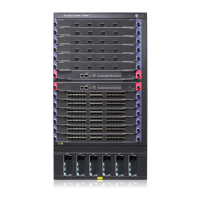198
VC encapsulations types
Before adding a VC label to a Layer 2 packet, a PE encapsulates the Layer 2 packet according to the AC
link type. VC encapsulation types for an Ethernet AC link include Ethernet and VLAN.
• Ethernet—P-Tag is not transferred on a VC.
{ For a packet received from a CE:
If the packet contains a P-Tag, the PE removes the P-tag, encapsulates the packet, and sends it
over the VC. If the packet contains no P-tag, the PE directly encapsulates the packet and sends
it over the VC.
{ For a packet received from a VC:
If the user access mode is VLAN, the PE adds the P-Tag to the packet and forwards it the CE.
If the user access mode is Ethernet, the PE directly forwards the packet to the CE.
• VLAN—Packets transmitted over a VC must carry a P-Tag.
{ For a packet received from a CE:
If the peer PE does not require the ingress to rewrite the P-tag, the PE keeps the P-Tag
unchanged, encapsulates the packet, and sends it over the VC. If the packet contains no P-tag,
the PE adds a null label (the label value is 0) into the packet, encapsulates the packet, and
sends it over the VC.
If the peer PE requires the ingress to rewrite the P-tag, the PE changes the P-Tag to the VLAN tag
(the tag may be a null tag) expected by the peer PE, encapsulates the packet, and sends it over
the VC. If the packet contains no P-tag, the PE adds a VLAN tag expected by the peer PE (the
tag value may be 0), encapsulates the packet, and sends it over the VC.
{ For a packet received from a VC:
If the user access mode is VLAN, the PE rewrites, or retains the P-tag and forwards the packet
to the CE. If the user access mode is Ethernet, the PE removes the P-tag and forwards the packet
to the CE.
MPLS L2VPN configuration task list
To set up a remote VC connection between two PEs, complete the following tasks:
• Configure an IGP on PEs and P devices to ensure IP connectivity in the backbone.
• Configure MPLS, GRE, or MPLS TE to set up tunnels across the backbone network.
• Configure tunneling policies on PEs to select tunnels for the VC.
• Configure MPLS L2VPN, set up the VC, and bind the AC to the VC.
To set up a local VC connection, you only need to bind two ACs on the PE.
This document only describes the MPLS L2VPN-related configurations on PEs. The MPLS L2VPN is
transparent to a customer network. You do not need to perform MPLS L2VPN-specific configurations on
CEs.
To configure MPLS L2VPN on a PE:

